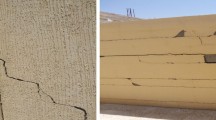Summary
A detailed estimation of engineering-geological properties of building soils should comprise the problems arising from specific features of these soils, especially if they are the so-called weak soils. Besides, engineering-geological research tends to be improved and the criteria are defined to expect the general features of soils in certain geological environments, that is in definite areas. During the present investigations fluvial flood deposits, muds, were examined. They are considered as weak soils and their unfavourable properties result from numerous factors: slight diagenesis, high moisture and considerable lithological variability. Holocene and recent muds were examined, coming from the valleys of the Vistula and the Odra as well as of their tributaries. Engineering-geological properties of muds were found to depend on lithology reflecting the conditions in the valley and the drainage basin during deposition. The following parameters were found to be the most significant: grain size composition (clay fraction in all soil types and sand fraction in not very cohesive soils), conten of organic matter (over 1 per cent), moisture, and, from the parameters that describe the soil state, liquid limit to reflect the physico-chemical properties of muds and their activity to water. The results obtained and recorded relationships should be applied among others during the preparation of maps and in engineering-geological regionalization of river valleys.
Résumé
L'estimation détaillée des propriétés des sols de fondation doit tenir compte des problèmes résultant de la spécificité des sols étudiés, surtout dans les cas de sols de faible rèsistance. Dans les recherches de géologie de l'ingénieur il y a en plus une tendance à la rationalisation et à la normalisation des critères, qui permettraient de prévoir les propriétés générales des sols liées à certaines conditions géologiques régionales. Les dépôts fluviaux d'inondation ont été examinés au cours de ces recherches. Ces dépôts ont une faible résistance et leurs propriétés défavorables résultent de plusieurs facteurs: faible diagénése, forte humidité et importante variabilité lithologique. On a étudié les sols alluviaux de l'époque holocéne et récente, déposés dans les vallées de la Vistule et de l'Oder et leurs affluents. On a mis en évidence que les propriétés géotechniques des sols alluviaux dépendent de leur lithologie et des conditions de drainage pendant la sédimentation. Les paramétres suivants sont les plus importants: la granularité, la proportion de fraction argileuse et sableuse dans les sols peu cohérents, la proportion de la matiére organique (plus de 1%), l'humidité et, parmi les paramètres caractérisant l'état des sols: la limite de liquidité comme trait représentatif des propriétés physico-chimiques des sols alluviaux et de leur sensibilité à l'eau. Les résultats obtenus et les corrélations enregistrées doivent être appliqués aux travaux cartographiques et à la régionalisation de la géologie d'ingénieur des vallées fluviales.
Similar content being viewed by others
References
CASAGRANDE A.I. (1948): Classification and identification of soils.Proc. ASCE, 74 (3).
FALKOWSKI E. (1971): Historia i prognoza rozwoju ukladu koryta wybranych odcinków rzek nizinnych Polski.Biul. Geol. UW, 12, 5–122.
FALKOWSKI E. (1980): Problemy genezy i interpretacji uksztaltowania doliny środkowej i dolnej Wisly.Przegl. Geol., 8, 345–347.
FRANKOWSKI Z. (1980): Metody ustalania wlasności gruntów slabonośnych na przykladzie utworów facji powodziowej doliny Wisly kolo Karczewa.Biul. Inst. Geol., 327, 55–103.
MYŚLIŃKA E. (1965): Wplyw warunków sedymentacji i diagenezy ilów warwowych zlodowacenia środkowopolskiego na obszarze Mazowsza na ich wlasności insyniersko-geologiczne.Biul. Geol. UW, 7, 3–106.
MYŚLIŃSKA E. (1983): Lithology of flood deposits as a criterion for the evaluation of changes in a drainage basin.Bull. IAEG. 28, 251–255.
MYŚLIŃSKA E. (1984): Kryteria oceny inzyniersko-geologicznych wlaściwości mad.Kwart. Geol., 28 (1), 141–162.
MYŚLIŃSKA E., HOFFMANN E. and KULESZA-WIEWIÓRA K. (1982). Zróźnicowanie litologiczne mad w wybranych odcinkach doliny Wisly.Przgl Geol., 9, 484–489.
SEED B., WOODWARD R. and LUNDGREN R. (1964): Clay mineralogical aspects of the Atterberg limits.J. Sol. Mech. Found. Dir. Proc. ASCE SM, 4.
Author information
Authors and Affiliations
Rights and permissions
About this article
Cite this article
Myślińska, E. Engineering-geological problems in research on flood deposits. Bulletin of the International Association of Engineering Geology 32, 105–109 (1985). https://doi.org/10.1007/BF02594772
Published:
Issue Date:
DOI: https://doi.org/10.1007/BF02594772




